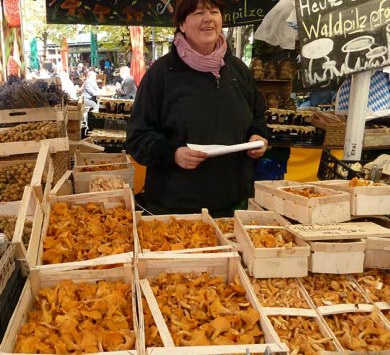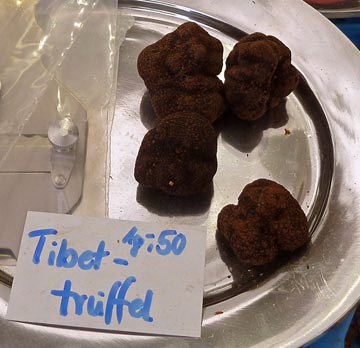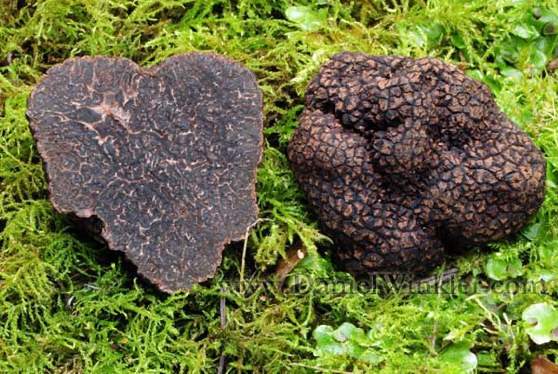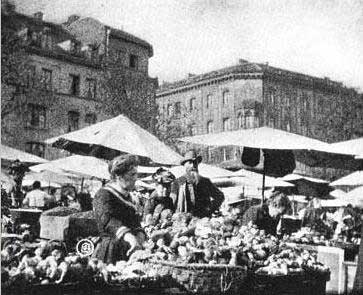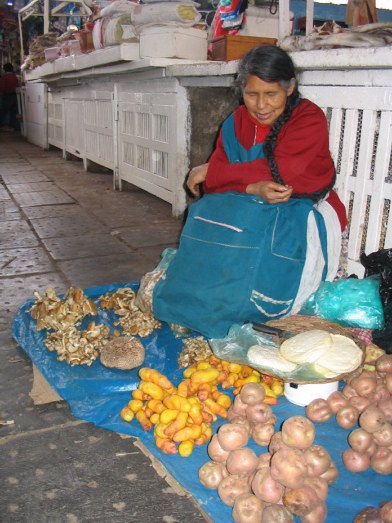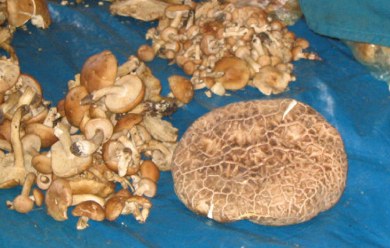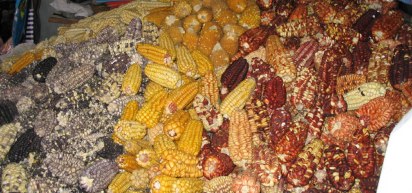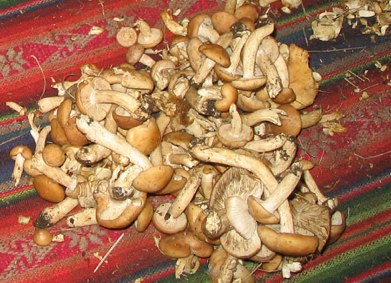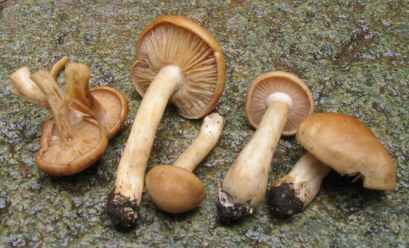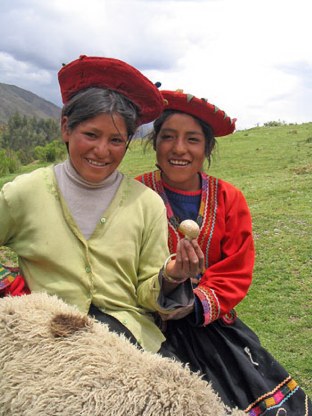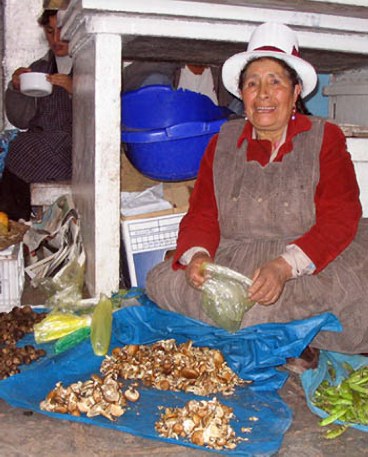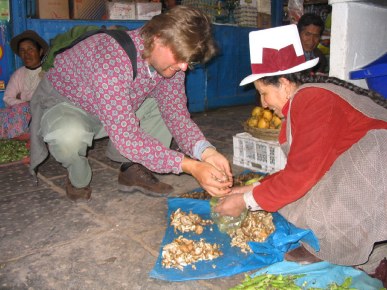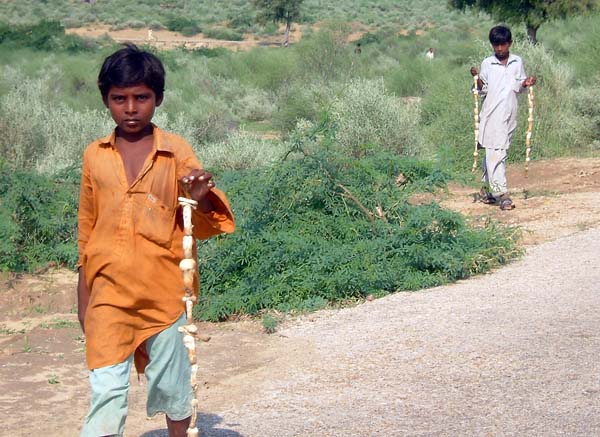|
Munich's "Viktualienmarkt" (Tibetan Truffles)
|
||||||
|
Early October 2007, I visited Munich's "Viktualienmarkt", a big outdoor-market offering victuals in Munich, where I grew up. The Viktualienmarkt is not just a simple farmers' market, it is one of Munich's best places to buy "Delikatessen" the old heart of town. Thus, selection and prices compare to high-end food stores.
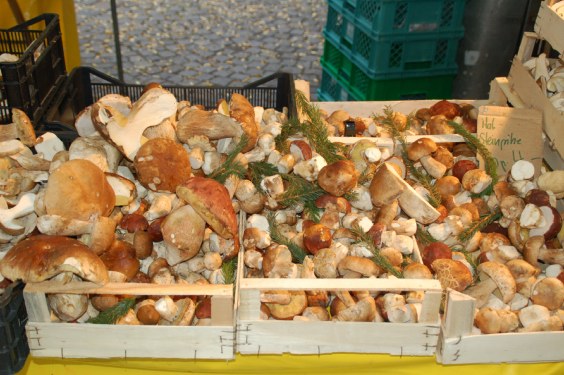 I checked for wild edible mushroom (WEF) species and their prices. As to be expected a wide range of Steinpilz (= king boletes, Boletus edulis) was available. They came in all sizes, classes and proveniences (i.e. Romania, Lithuania, Poland, Italy and Germany) from €20 per kg = $12.7/lb. Italian boletes cost €40 per kg = $25/lb.
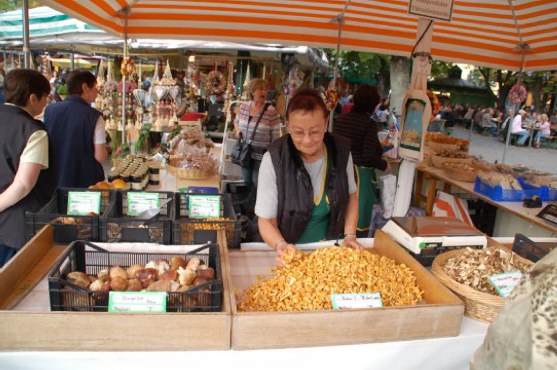 Even more common in stores in Germany than the Steinpilz is the Pfifferling, (mostly Cantharellus cibarius). Chanterelles are widely traded not only because of their great taste, but because of their propensity to stay fresh much longer than most gilled mushrooms and boletes. I saw them in many regular stores.
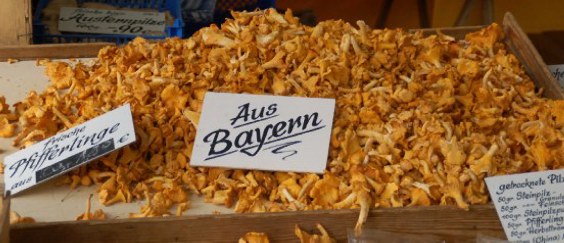 European chanterelles, just as the chanties in Tibet (Cantharellus cibarius and Cantharellus minor) are in general much smaller than American West coast specimens, which are absolutely unique regarding their size. However, there are people who claim that European ones are richer in aroma. I never ate them side by side, but I seem to recall that the ones I collected and ate in the Alps were actually stronger in taste. However, the Pacific Northwest chanties are so much bigger that they easily balance a supposed lack of aroma with sheer quantity. 1 kg chanterelles cost €16 (= $12/lb) at Viktualien Markt in Munich.
|
Viktualien Markt München
Munich's may pole
at the Viktualien Markt
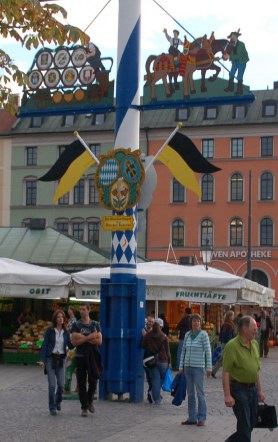 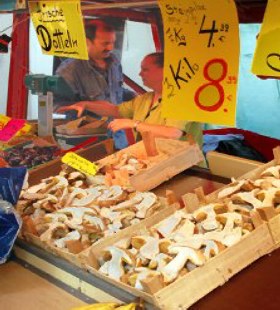 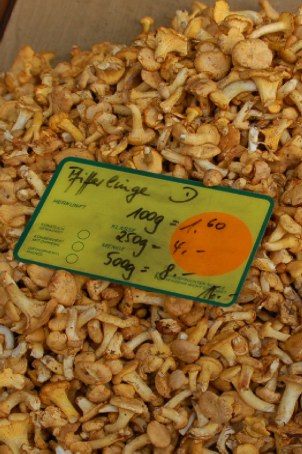 |
|||||
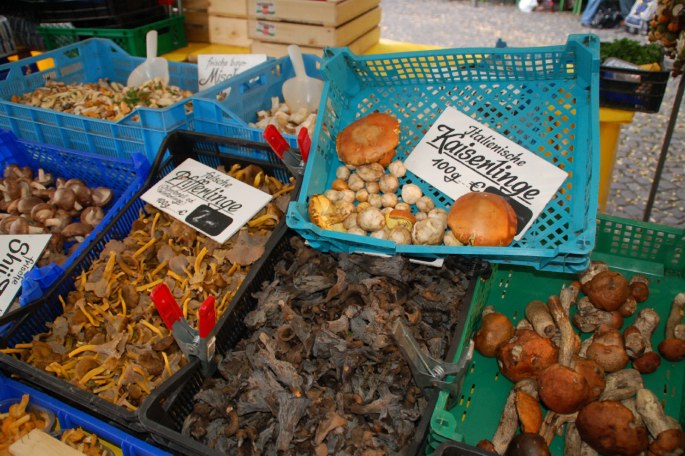 |
||||||
|
From left to right: Yellow foot or funnel chanterelles ("Trompeten-Pfifferling", Craterellus tubaeformis = C. infundibuliformis) €20 per kg = $12.7/lb
Horn of plenty or black trumpet (Herbst-Trompete or Toten-Trompete, Craterellus cornucopioides) €30 per kg = $19/lb
Red caps ("Rotkappen", Leccinum versipelle and L. aurantiacum) and one birch boletes (Leccinum scabrum)
Top right: I was surprised to find the Caesar's mushroom ("Kaiserling", Amanita caesarea), which is imported from Italy and sold for hefty €60 per kg = $38/lb. In Germany they are very rare and limited to the warmest sites along the Rhine valley. Growing up in Munich I never saw a "Kaiserling" on the market.
|
||||||
|
Hedgehogs ("Semmel-Stoppelpilz", Hydnum repandum) at €20 per kg = $12.7/lb.
Other wild edibles sold:
Honey mushroom ("Hallimasch", Armillaria mellea, not depicted)
|
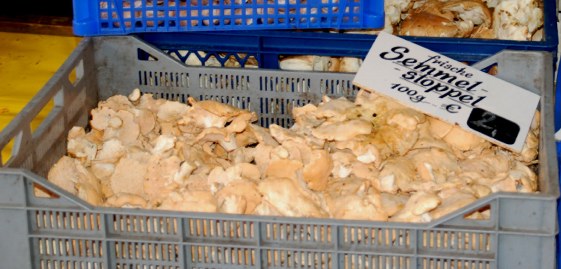 |
|||||
 Also available was White or Alba truffle ("Weisser Trüffel", Tuber magnatum at € 7.90/g = €237/oz = $330/oz),
Summer truffle ("BraunerTrüffel", Tuber aestivum Vitt. or T. unicinatum) at € 1.95/g = €59/oz = $83/oz) and Black truffle or Black Périgord Truffle ("Schwarzer Trüffel", Tuber melanosporum, €2.95/g = €85/oz = $120/oz). Wikipedia has a nice entry on truffles.
In early November 2011 at Viktualien-Markt, I came across "Tibetische Trüffel", meaning Tibetan truffles. My curiosity was perked, never did I hear anything about truffles being collected, eaten or traded in Tibet, but I also never looked for truffles during their fruiting season, which lasts from November through February. However, I have seen bags of frozen Tuber indicum (= T. sinensis) in Kunming's mushroom market, from where lot's of wild collected Tibetan mushrooms get exported as well.
So I asked Renate Zollner, who runs the mushroom booth at Viktualienmarkt [and published a book on mushroom cooking]. She knew it was a Tuber, but the common name was not her creation, but from her supplier who sold it as Tibetan truffle. My first reaction was this must be a new name to market Tuber indicum that is plentiful in SW China. So I did a bit of research and found out that this Tibetan truffle should be Tuber himalayensis. Both T. himalayensis and T. indicum look a lot like the fancy Tuber melanosporum - Périgord truffles, but they do not have the rich aroma, and consequently not the same price.
For a taste test I ground some raw Tibetan truffle on a chicken soup, that might have not been the most traditional approach, but that was dinner and the truffle could hold its ground, a rich, very earthy and gamy aroma. However, overall I would say it clearly improved the chicken soup, but it did not turn it into a culinary sensation or anything stellar.
The aroma of the truffle was a different experience. It smelled and tasted smoked - maybe it spend some time in a Tibetan farmhouse which is usually pervaded by smoke? Besides the smoky accent it also smelled a bit of yaks kept on the ground floor while hanging out in the kitchen above, wow! [The ground floor in Tibetan farm houses is reserved for livestock, the living quarters are 2nd floor]. Well, it seemed like that truffle had absorbed the taste of the collector's home, not too uncommon for mushrooms dried in farmhouse kitchens.
|
||||||
 Dried king boletes at €100kg = $62/lb
|
 Dried morels (Spitzmorcheln, Morchella conica) at €400/kg = $254/lb
|
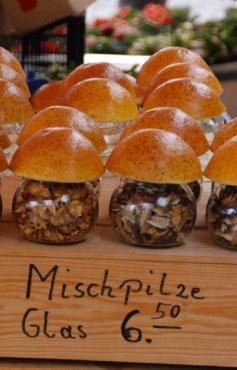 Mixed mushrooms
|
||||
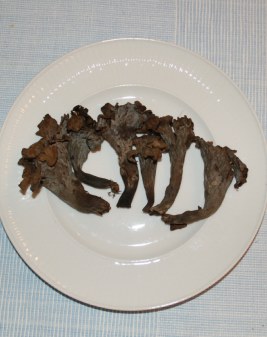 Black trumpets (Craterellus cornucopioides) Black trumpets (Craterellus cornucopioides) |
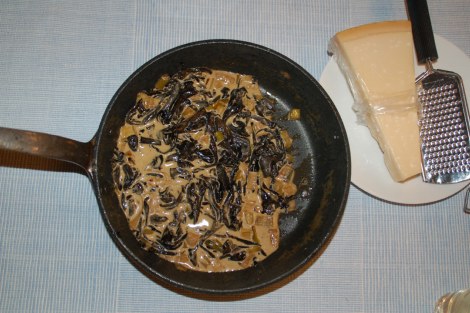 Trumpets in cream sauce, onions, white wine and a bit of Bavarian sweet mustard.
|
|||||
|
|
100 years back at the Viktualienmarkt...
|
|||||
|
Post-Chernobyl Radiating Mushrooms
In Munich as in many places in Europe mushrooms still get tested regularly for radiation. It was started after the April 1985 Chernobyl reactor melt down, to eliminate mushrooms illegally imported from Ukraine and neighboring countries most heavily impacted by radioactive fallout. Once in awhile there are still bunches with becquerel values up to 10,000, a multiple of the permitted threshold of 600 bq per kg. However, Bavaria itself got hit quite hard from the radioactive fallout in late April 1985. The first two years after Chernobyl I quit mushrooming. And later on I used to peel all the "Maronen-Röhrlinge" (Boletus / Xerocomus badius) I had picked, since we were told that the dark skin of the cap contained the highest concentration of cesium / caesium 137. Luckily Cs-137 has a half-life of 'only' 30 years. Bay boletes (Boletus badius) and hedgehogs (Hydnum repandum) collected in southern Bavaria still can reach values of up to 2,000 bq/kg, but averages are below the legal threshold. Between June and October samples are tested for free by "Umweltinstitut München e.V", a non-for profit environmental organization. Eating a pound of mushrooms with 3000bq/kg is supposed to expose your body to as much radiation as lung x-ray. Bavarian king boletes (Boletus edulis) or chanterelles (Cantharellus cibarius) now rarely exceeds the permitted threshold. Similarly, forest foraged berries are contaminated; Eating wild boar can expose you to up to 60,000 bq/kg. Mushrooms growing in lawns or fields (i.e. Macrolepiota procera, Marasmius oreades or many Agaricus species) have hardly any becquerels, since Cs-137 is only available for absorption by organisms in habitats with a well developed duff layer as in forest ecosystems. (German Source: http://www.umweltinstitut.org/atom)
(next to the Cathedral)
While attending the 4th International Medicinal Mushroom Conference in Ljubljana, at the main market I saw king boletes (Boletus edulis & B. pinicola), chanterelles, gypsy mushrooms (Rozites / Cortinarius caperata), a variety of Leccinum species and a greenish Brittlegill, probably Russula cyanoxantha . During the week there was slim picking, but I was told that during Saturday market, the main market day, the tables are loaded with mushrooms.
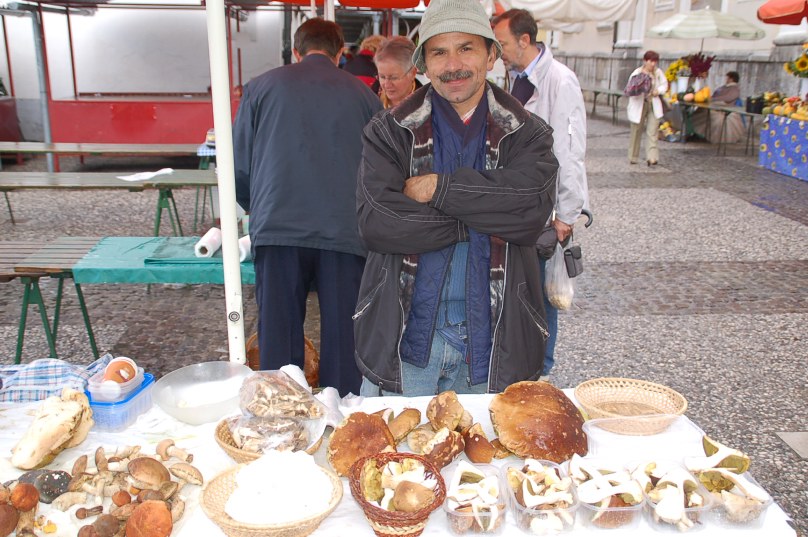 |
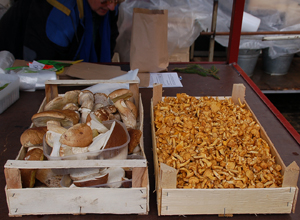 Slovenia is Europe's second most forested country by percentage and mushrooms are collected by many people. King boletes and chanterelles are some of the most important commercial species. Interestingly collecting truffles was illegal until 2011. When I was there forestry officials were working on changing this absurd law and apparently succeeded.
|
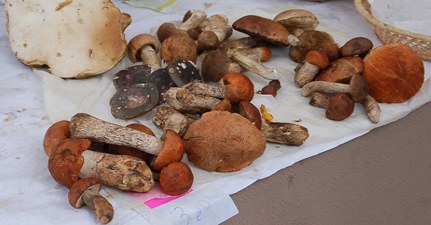 A variety of Leccinum species, some king boletes and four greenish Brittlegills* (probably Russula cyanoxantha) and behind the Russulae is a lonesome gypsy (Rozites caperata = Cortinarius caperatus) right next to a big old pale king bolete (Boletus edulis).
* Brittlegill, what a nice descriptive British name! I found it in a list on official British mushroom names. Here the link for pasting in: htpp://www.britmycolsoc.org.uk/files/ENGLISH_NAMES.pdf
|
||||
|
Vegetable Market - January 2007
African Mushroom Markets
(All photos and information generously provided by Tom Furtwangler)
|
|||||
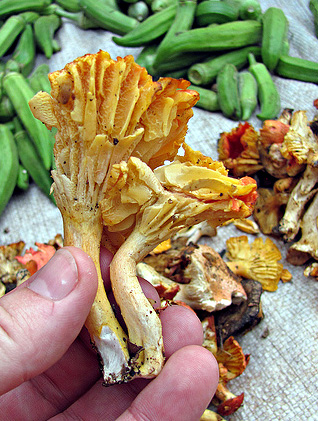 Mixed edible mushrooms found by Tom Furtwangler at the market in Nampula, a big prefectural town in the Northeast of Mozambique. Clearly recognizable are yellow chanterelles. It is not so clear what kind of mushroom the reddish one is. Could it be another Cantharellus or a Hygrophorus?
Several research papers have been published on mushrooms collected from the Miombo forest in neighboring Malawi and also South Tanzania just north of Mozambique, where people collect species of Cantharellus.
Photos: © Tom Furtwangler, Nampula, March 23, 2010.
|
 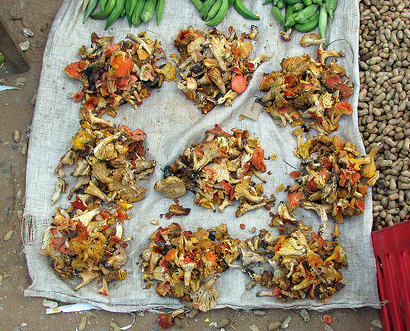 Last Change Nov. 2010
|
||||
|
(All photos and information generously provided by Shannon Adams, Seattle)
|
|||||
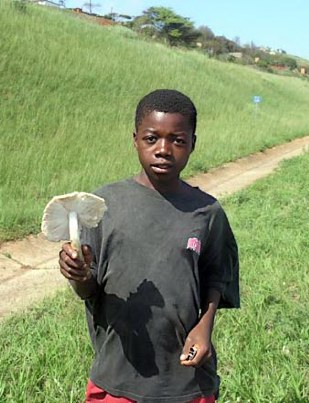 Termite mushroom - Termitomyces sp. for sale by the highway in Durban, South Africa. "As kids we kept our eyes open for children selling them by the road. My father would screech to a halt when we spotted someone holding one up (from 60 mph) and then negotiate dinner".
|
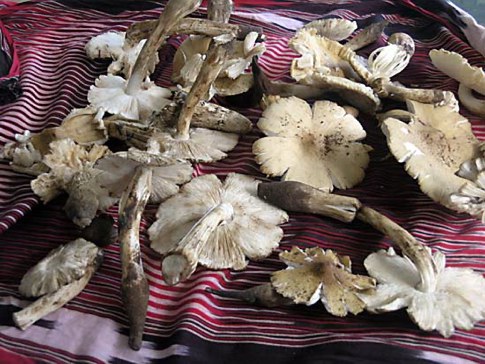 Termite mushrooms are delicious and they often grow huge. However, maggots often infest the larger ones (we always ate them, regardless but you can't hold them overnight!). In Durban, you have to ask the Zulu locals for "i'khowe" (or "amakhowe"), which means mushroom, but is generally understood to be THIS mushroom. Photos & text: © Shannon
|
||||
|
(All photos and information generously provided by Muhammad Ismail Bhatti)
|
|||||
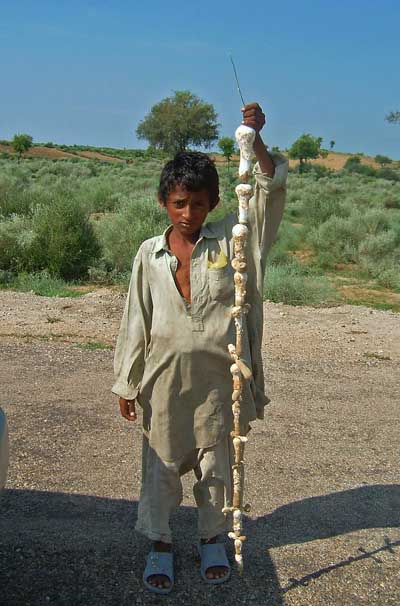 Kids help collecting this local favorite.
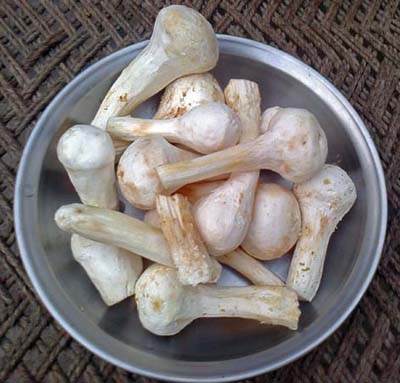 Cleaned Khumbi
-
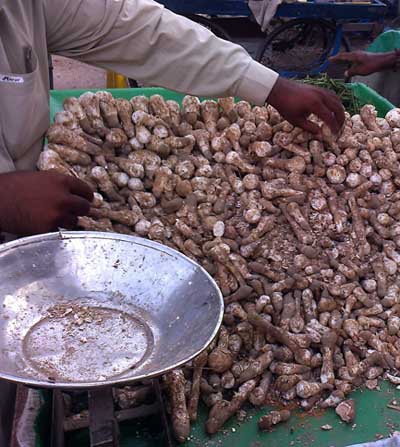
Added 12-28-2012
|
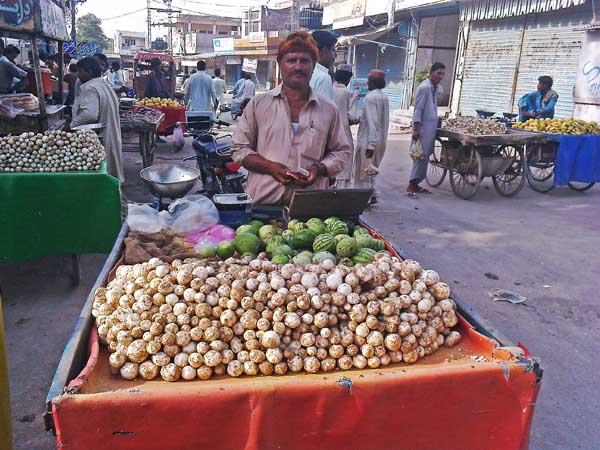 On the market of Umerkot in Sindh, Pakistan lots of "Khumbi" (Podaxis pistillaris) are offered for sale. Usually 1 kg cost 100 to 150 Pakistani Rupees (about 1 to 1.5 US$). Some people preserve the mushroom as food and for medicinal purpose (see below for details).
All photos copyright by Muhammad Ismail Bhatti : 20-09-2012 People collect Khumbi mushrooms during the monsoon rainy season in August or September. Note the collectors in the shrubs in the back. Amongst the collectors of Podaxis pistillaris are many children in school age (8-15 years) They also sell them directly along the roads. Also, many people living in the country site collect Khumbi in the desert areas and send these mushrooms as a gift to friends and family living in the cities. Khumbi is the common name in Hindi, Sindhi, Urdu and Punjabi. Local people call other wild mushrooms “Snake caps”in order to warn children, so they stay away from eating other wild mushrooms to avoid mushroom poisonings.
All photos and information provided by : Muhammad Ismail Bhatti M.Sc,. Ph.D |
||||

